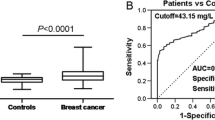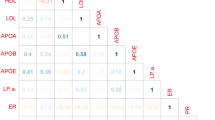Abstract
Purpose
Apolipoprotein M (APOM) is a plasma apolipoprotein closely involved with lipid metabolism and inflammation. In vitro studies suggest that APOM may also have a tumor-suppressive role in breast cancer. In the present study, we aimed to evaluate the impact of plasma APOM levels on the prognosis of breast cancer patients.
Methods
We measured APOM levels using an enzyme-linked immunosorbent assay in 75 patients with ER-positive/HER2-negative metastatic breast cancer. The endpoint was overall survival (OS) at 24 months.
Results
During the 24-month follow-up period, 34.7% of the patients died. Baseline APOM levels were significantly reduced in patients who deceased during follow-up compared to survivors (42.7 ± 14.5 µg/mL versus 52.2 ± 13.8 µg/mL; P = 0.003). Cox regression analysis showed a hazard ratio of 0.30 [95% confidence interval 0.15–0.61]; P < 0.001 per doubling of APOM levels. Correction for age, C-reactive protein, menopausal state, histology of the primary tumor, metastatic site, number of metastases, endocrine resistance, scheduled therapy line, and kind of scheduled therapy indicated that circulating APOM predicted OS independently of these parameters (HRper doubling = 0.23 [0.09–0.56; P = 0.001).
Conclusions
Our study suggests that circulating APOM is significantly linked with reduced mortality in metastatic breast cancer patients.


Similar content being viewed by others
Data availability
The datasets generated during and/or analyzed during the current study are available from the corresponding author upon reasonable request.
References
Bray F, Ferlay J, Soerjomataram I et al (2018) Global cancer statistics 2018: GLOBOCAN estimates of incidence and mortality worldwide for 36 cancers in 185 countries. CA Cancer J Clin 68:394–424. https://doi.org/10.3322/CAAC.21492
Cardoso F, Costa A, Senkus E et al (2017) 3rd ESO-ESMO international consensus guidelines for advanced breast cancer (ABC 3). Ann Oncol 28:3111. https://doi.org/10.1093/ANNONC/MDX036
Burstein HJ, Somerfield MR, Barton DL et al (2021) Endocrine treatment and targeted therapy for hormone receptor-positive, human epidermal growth factor receptor 2-negative metastatic breast cancer: ASCO guideline update. J Clin Oncol 39:3959–3977. https://doi.org/10.1200/JCO.21.01392
Xu N, Dahlbäck B (1999) A novel human apolipoprotein (apoM). J Biol Chem 274:31286–31290. https://doi.org/10.1074/JBC.274.44.31286
Obinata H, Hla T (2012) Sphingosine 1-phosphate in coagulation and inflammation. Semin Immunopathol 34:73. https://doi.org/10.1007/S00281-011-0287-3
Therond P, Chapman MJ (2022) Sphingosine-1-phosphate: metabolism, transport, atheroprotection and effect of statin treatment. Curr Opin Lipidol 33:199–207. https://doi.org/10.1097/MOL.0000000000000825
Ruiz M, Frej C, Holmér A et al (2017) High-density lipoprotein-associated apolipoprotein M limits endothelial inflammation by delivering sphingosine-1-phosphate to the sphingosine-1-phosphate receptor 1. Arterioscler Thromb Vasc Biol 37:118–129
Zhang XY, Dong X, Zheng L et al (2003) Specific tissue expression and cellular localization of human apolipoprotein M as determined by in situ hybridization. Acta Histochem 105:67–72. https://doi.org/10.1078/0065-1281-00687
Bai Y, Pei W, Zhang X et al (2021) ApoM is an important potential protective factor in the pathogenesis of primary liver cancer. J Cancer 12:4661. https://doi.org/10.7150/JCA.53115
Zhou Y, Yao S, Yu M et al (2022) The effects and possible mechanism of action of apolipoprotein M on the growth of breast cancer cells. Mol Biol Rep 49:1171–1179. https://doi.org/10.1007/S11033-021-06945-2
Györffy B, Lanczky A, Eklund AC et al (2010) An online survival analysis tool to rapidly assess the effect of 22,277 genes on breast cancer prognosis using microarray data of 1809 patients. Breast Cancer Res Treat 123:725–731. https://doi.org/10.1007/S10549-009-0674-9
Youden WJ (1950) Index for rating diagnostic tests. Cancer. 3:32
Faul F, Erdfelder E, Lang AG, Buchner A (2007) G*Power 3: a flexible statistical power analysis program for the social, behavioral, and biomedical sciences. Behav Res Methods 39:175–191. https://doi.org/10.3758/BF03193146
Zhang X, Bai Y, Zhu W et al (2022) ApoM regulates PFKL through the transcription factor SREBF1 to inhibit the proliferation, migration and metastasis of liver cancer cells. Oncol Lett. https://doi.org/10.3892/OL.2022.13331
Xue H, Yu M, Zhou Y et al (2020) Apolipoprotein M inhibits proliferation and migration of larynx carcinoma cells. Sci Rep. https://doi.org/10.1038/S41598-020-76480-W
Yu MM, Yao S, Luo KM et al (2017) Apolipoprotein M increases the expression of vitamin D receptor mRNA in colorectal cancer cells detected with duplex fluorescence reverse transcription-quantitative polymerase chain reaction. Mol Med Rep 16:1167–1172. https://doi.org/10.3892/MMR.2017.6716
Bao J, Zhu L, Zhu Q et al (2016) SREBP-1 is an independent prognostic marker and promotes invasion and migration in breast cancer. Oncol Lett 12:2409–2416. https://doi.org/10.3892/OL.2016.4988
Huss L, Butt ST, Borgquist S et al (2019) Vitamin D receptor expression in invasive breast tumors and breast cancer survival. Breast Cancer Res. https://doi.org/10.1186/S13058-019-1169-1
Zhu Y, Luo G, Jiang B et al (2018) Apolipoprotein M promotes proliferation and invasion in non-small cell lung cancers via upregulating S1PR1 and activating the ERK1/2 and PI3K/AKT signaling pathways. Biochem Biophys Res Commun 501:520–526. https://doi.org/10.1016/J.BBRC.2018.05.029
Mu Q, Luo G, Wei J et al (2021) Apolipoprotein M promotes growth and inhibits apoptosis of colorectal cancer cells through upregulation of ribosomal protein S27a. EXCLI J. 20:145–159. https://doi.org/10.17179/EXCLI2020-2867
Nielsen LB, Christoffersen C, Ahnström J, Dahlbäck B (2009) ApoM: gene regulation and effects on HDL metabolism. Trends Endocrinol Metab 20:66–71. https://doi.org/10.1016/J.TEM.2008.11.003
Cheng G, Zheng L (2022) Regulation of the apolipoprotein M signaling pathway: a review. J Recept Signal Transduct Res 42:285–292. https://doi.org/10.1080/10799893.2021.1924203
Zheng Z, Zeng Y, Zhu X et al (2019) ApoM-S1P modulates Ox-LDL-induced inflammation through the PI3K/Akt signaling pathway in HUVECs. Inflammation 42:606–617. https://doi.org/10.1007/S10753-018-0918-0
Gao JJ, Hu YW, Wang YC et al (2015) ApoM suppresses TNF-α-induced expression of ICAM-1 and VCAM-1 through inhibiting the activity of NF-κB. DNA Cell Biol 34:550–556. https://doi.org/10.1089/DNA.2015.2892
Shi Y, Liu H, Liu H et al (2020) Increased expression levels of inflammatory cytokines and adhesion molecules in lipopolysaccharide-induced acute inflammatory apoM-/- mice. Mol Med Rep 22:3117–3126. https://doi.org/10.3892/MMR.2020.11426
Xia L, Tan S, Zhou Y et al (2018) Role of the NFκB-signaling pathway in cancer. Onco Targets Ther 11:2063–2073. https://doi.org/10.2147/OTT.S161109
Kumaraswamy SB, Linder A, Åkesson P, Dahlbäck B (2012) Decreased plasma concentrations of apolipoprotein M in sepsis and systemic inflammatory response syndromes. Crit Care. https://doi.org/10.1186/CC11305
Feingold KR, Shigenaga JK, Chui LG et al (2008) Infection and inflammation decrease apolipoprotein M expression. Atherosclerosis 199:19–26. https://doi.org/10.1016/J.ATHEROSCLEROSIS.2007.10.007
Mosialou I, Krasagakis K, Kardassis D (2011) Opposite regulation of the human apolipoprotein M gene by hepatocyte nuclear factor 1 and Jun transcription factors. J Biol Chem 286:17259–17269. https://doi.org/10.1074/JBC.M110.200659
Mosialou I, Zannis VI, Kardassis D (2010) Regulation of human apolipoprotein m gene expression by orphan and ligand-dependent nuclear receptors. J Biol Chem 285:30719–30730. https://doi.org/10.1074/JBC.M110.131771
Chen J, Pan Y, He B et al (2018) Meta-analysis of prognostic value of inflammation parameter in breast cancer. J Cancer Res Ther 14:S85–S89. https://doi.org/10.4103/0973-1482.160917
Dethlefsen C, Højfeldt G, Hojman P (2013) The role of intratumoral and systemic IL-6 in breast cancer. Breast Cancer Res Treat 138:657–664. https://doi.org/10.1007/S10549-013-2488-Z
Mikkelsen MK, Lindblom NAF, Dyhl-Polk A et al (2022) Systematic review and meta-analysis of C-reactive protein as a biomarker in breast cancer. Crit Rev Clin Lab Sci 59:480–500. https://doi.org/10.1080/10408363.2022.2050886
Liu M, Frej C, Langefeld CD et al (2019) Plasma apoM and S1P levels are inversely associated with mortality in African Americans with type 2 diabetes mellitus. J Lipid Res 60:1425–1431. https://doi.org/10.1194/JLR.P089409
Ahnström J, Gottsäter A, Lindblad B, Dahlbäck Björn B (2010) Plasma concentrations of apolipoproteins A-I, B, and M in patients with critical limb ischemia. Clin Biochem 43:599–603. https://doi.org/10.1016/J.CLINBIOCHEM.2010.01.001
Chirinos JA, Zhao L, Jia Y et al (2020) Reduced apolipoprotein M and adverse outcomes across the spectrum of human heart failure. Circulation 141:1463–1476. https://doi.org/10.1161/CIRCULATIONAHA.119.045323
Hart CD, Migliaccio I, Malorni L et al (2015) Challenges in the management of advanced, ER-positive, HER2-negative breast cancer. Nat Rev Clin Oncol 12:541–552. https://doi.org/10.1038/NRCLINONC.2015.99
Funding
This present study was partly financed by the European Regional Development Fund through the INTERREG V program ‘Alpenrhein-Bodensee-Hochrein,’ project number: ABH055.
Author information
Authors and Affiliations
Contributions
All authors contributed to the study conception and design. Conception and design of the study were performed by TD and AM. Patients’ recruitment, sample, and data collection were carried out by TD, TD, KG, and SG. Material preparation, sample analysis, and data analysis were performed by CH, EMB, HD, and AL. The first draft of the manuscript was written by AM and all authors commented on the previous versions of the manuscript. All authors read and approved the final manuscript.
Corresponding author
Ethics declarations
Conflict of interest
The authors have no relevant financial or non-financial interests to disclose.
Ethical approval
This study was performed in line with the principles of the Declaration of Helsinki. Approval was granted by the State Chamber of Medicine of Baden-Württemberg (F-2017-046).
Consent to participate
Informed consent was obtained from all individual participants included in the study.
Additional information
Publisher's Note
Springer Nature remains neutral with regard to jurisdictional claims in published maps and institutional affiliations.
Supplementary Information
Below is the link to the electronic supplementary material.
Rights and permissions
Springer Nature or its licensor (e.g. a society or other partner) holds exclusive rights to this article under a publishing agreement with the author(s) or other rightsholder(s); author self-archiving of the accepted manuscript version of this article is solely governed by the terms of such publishing agreement and applicable law.
About this article
Cite this article
Muendlein, A., Heinzle, C., Brandtner, E.M. et al. Plasma apolipoprotein M predicts overall survival in metastatic breast cancer patients. Breast Cancer Res Treat 201, 571–576 (2023). https://doi.org/10.1007/s10549-023-07045-4
Received:
Accepted:
Published:
Issue Date:
DOI: https://doi.org/10.1007/s10549-023-07045-4




